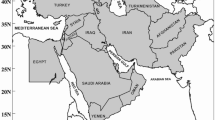Abstract
Eupatorium leonardii, presently known only from Mt. Mingan in the border region between Aurora and Nueva Ecija Provinces in Luzon, Philippines, is described and illustrated. The new species is remarkable because it is the only woody representative of the genus with a peculiar spiral phyllotaxy. Previously, Eupatorium s. str. consisted of herbs with opposite or verticillate phyllotaxy.


Similar content being viewed by others
Literature Cited
Bentham, G. 1873. Compositae. Pp. 163–533. In: G. Bentham & J. D. Hooker (eds.), Genera plantarum, vol. 2(1). Lovell Reeve & Co., Williams & Norgate, London.
Bremer, K. 1994. Asteraceae. Cladistics and classification. Timber Press, Portland, Oregon.
Co, L. L., U. F. Ferreras, N. A. Bartolome & F. M. Dalin. 2007. The forest vegetation of Mingan Mountains. Unpublished report to Conservation International Philippines.
Elmer, A. D. E. 1906. Manual of the Philippine Compositae. Leaflets of Philippine Botany 1: 83–186.
———. 1915. Two hundred twenty six new species—I. Leaflets of Philippine Botany 7: 2543–2700.
Ferreras, U. F. & W. Suarez. 2009. Mycaranthes leonardoi and Robiquetia enigma: two new orchid species from the Philippines. Australian Orchid Review 74: 37–39.
——— & G. Argent. 2011. Diplycosia bartolomei (Ericaceae): a new species from the Philippines. Edinburgh Journal of Botany 68: 33–38.
Funk, V. A., A. Susanna, T. F. Stuessy & R. J. Bayer (eds.). 2009. Systematics, evolution, and biogeography of Compositae. International Association for Plant Taxonomy, Vienna, Austria.
Ito, M., K. Watanabe, Y. Kitai, T. Kawahara, D. J. Crawford & T. Yahara. 2000a. Phylogeny and phytogeography of Eupatorium (Eupatorieae, Asteraceae): insights from sequence data of the nrDNA ITS regions and cpDNA RFLP. Journal of Plant Research 113: 79–89.
———, T. Yahara, R. M. King, K. Watanabe, S. Oshita, J. Yokoyama & D. J. Crawford. 2000b. Molecular phylogeny of Eupatorieae (Asteraceae) estimated from cpDNA RFLP and its implication for the polyploidy origin hypothesis of the tribe. Journal of Plant Research 113: 91–96.
IUCN. 2001. The IUCN red list of threatened species. Categories & Criteria (version 3.1). Prepared by the IUCN Species Survival Commission. IUCN, Gland, Switzerland, and Cambridge, United Kingdom.
King, R. M. & H. Robinson. 1987. The genera of the Eupatorieae (Asteraceae). Monographs in Systematic Botany from the Missouri Botanical Garden, vol. 22. Missouri Botanical Garden, St. Louis.
Koster, J. T. 1935. The Compositae of the Malay Archipelago, I. Vernonieae and Eupatorieae. Blumea 1: 351–536.
Merrill, E. D. 1912. New or noteworthy Philippine plants, IX. Philippine Journal of Science 7: 259–357.
PAG-ASA-IRI-LDEO Climate Library. 2011. http://iridl.ldeo.columbia.edu/SOURCES/.PAGASA/.monthly/.station/index.html (accessed November, 2011).
Robinson, B. L. 1934. Records preliminary to a general treatment of the Eupatorieae, XI. Contributions from the Gray Herbarium of Harvard University n.s. 104: 3–49.
Robinson, C. B. 1908. Alabastra Philippinensia, II. Philippine Journal of Science 3: 175–218.
Schilling, E. E., J. L. Panero & P. B. Cox. 1999. Chloroplast DNA restriction site data support a narrowed interpretation of Eupatorium (Asteraceae). Plant Systematics and Evolution 219: 209–223.
Schmidt, G. T. & E. E. Schilling. 2000. Phylogeny and biogeography of Eupatorium (Asteraceae: Eupatorieae) based on nuclear ITS sequence data. American Journal of Botany 87: 716–726.
Siripun K. C. & E. E. Schilling. 2006. Eupatorium. Pp. 462–474. In: Flora of North America Editorial Committee (eds.). Flora of North America North of Mexico, vol. 21, Magnoliophyta: Asteridae, part 8: Asteraceae, part 3. Oxford University Press, New York.
Acknowledgments
We are grateful to Conservation International Philippines for funding the 2006 expedition to the Sierra Madre, with special thanks to Mariano Roy Duya and Grace Rosell-Ambal; Victor Dacumos of the Nueva Ecija University of Science and Technology, for hospitality; the DENR Regional Office for granting Gratuitous & Transport Permits, with special thanks to Nestor Bartolome and Frank Dalin; Harold Robinson and Vicki Funk for discussions on the generic placement of this new species; Bobbi Angell for the excellent illustration; Carol Gracie for digitally formatting Figure 2; Scott Mori for discussion on the trichomes of E. leonardii; and Edward Schilling and Harold Robinson for their reviews the manuscript.
Author information
Authors and Affiliations
Corresponding author
Rights and permissions
About this article
Cite this article
Lamont, E.E., Ferreras, U.F. A new species of Eupatorium (Asteraceae) from the Philippines. Brittonia 64, 368–373 (2012). https://doi.org/10.1007/s12228-012-9249-x
Published:
Issue Date:
DOI: https://doi.org/10.1007/s12228-012-9249-x




